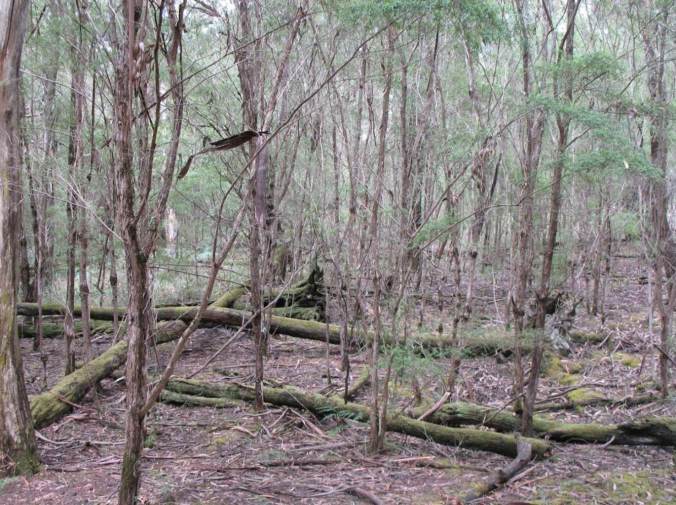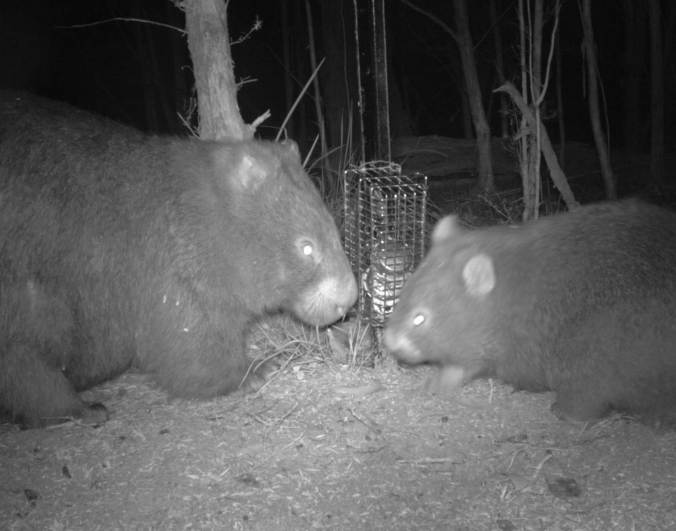What do you think about emotive language in science?
Are foxes invasive feral vermin, or simply introduced? When shrub cover increases, should we describe the process as shrub encroachment, invasion, expansion or woody thickening? Does it make a difference if the shrub species is indigenous?
In a paper now available in Austral Ecology early view, we looked at associations between native mammal occurrence and Yarra Burgan (Kunzea leptospermoides) canopy cover in a eucalypt forest. Yarra Burgan is native to the Yarra Valley, but has spread rapidly within Coranderrk Bushland Reserve over the past 20 years. Burgan grows to more than 10 m tall, shades out understorey plants and doesn’t appear to be eaten by anything much.

Areas ‘encroached’ by Burgan had a sparse, mossy understory and many fallen trees
Our vegetation surveys showed that sites with high Burgan cover had a sparser understorey, fewer grasses and higher moss cover than sites without Burgan. More of the eucalypts at Burgan-encroached sites were dead, and there were greater volumes of logs and fallen branches. So Burgan expansion is definitely associated with changes in vegetation. In some cases, though, it’s a chicken-and-egg problem: did the eucalypt trees die from competition with Burgan or did Burgan colonise the areas where eucalypts had died?
In contrast, native mammals didn’t seem to care either way. Echidnas, antechinus, long-nosed bandicoots and swamp rats all preferred sites with dense understorey, and eastern grey kangaroos were associated with high grass cover; but each species was just as likely to be found at sites where Burgan cover was high as sites where it was low. Swamp wallabies occurred everywhere and showed a temporal pattern in habitat selection, spending their days at sites with dense Burgan cover and their nights in open areas.

Swamp wallabies enthusiastically investigated our cameras and bait stations, triggering >9000 sets of images
Shrub expansion (perhaps the most neutral term, although it doesn’t work well as an adjective – shrub-expanded forest sounds rather peculiar whereas shrub-encroached works fine, and we used both in the paper) is widely perceived as a negative process. Most previous studies have focused on grasslands (where shrub expansion reduces grazing for livestock) or examined the effects on flora: plant diversity is generally lower in areas with dense shrub cover.
There is no doubt that shrubs need to be managed at some locations (now is that neutral language, or just a euphemistic way of saying chopped down?) Nonetheless, it is important that the language we use doesn’t bias our decisions: Burgan might be invasive but it also supports high invertebrate abundance and richness, provides nesting habitat for woodland birds, shelter for macropods, roost sites for powerful owls (a family bred in the Coranderrk while we were conducting this research), and the rotting eucalypt trees and logs in areas with dense Burgan presumably provide good foraging and shelter resources for insectivorous mammals and birds. How we manage shrub-encroached forests will depend on which aspects of the biota we value most.
Emotive language can be great for attracting public attention, but we should take care that it doesn’t shape our science.

It’s a minefield, isn’t it – choosing the right language without watering it down for the sake of neutrality or, alternatively, using lazily emotive terms? If a scientist feels that foxes are ‘invading,’ it must be tempting to try to communicate that emotion to the reader. But, as you say, the scientist’s perception might be disputed by the foxes, who probably can’t believe their luck in finding pastures new. If history’s written by the victor, I suppose science is written by the human.
I suppose, even if you invented new words or used Latinate words, they would become layered with extra messages of emotion in the minds of your readers, as time passed. Tricky, isn’t it?
Great points Singbetterenglish – I hadn’t quite got to thinking of it from the fox’s perspective! Preferred/PC terminology definitely shifts over time, depending on how old terms have been used. It’s very tempting – and probably desirable – to use some emotional language when you are trying to share your science. Storytelling definitely has its place – as https://wildlifesnpits.wordpress.com/2015/03/11/stories-for-scientists/ explains so well. It’s interesting, though, how the the words you use might then come back and shape your own thinking.
Thanks for that link. We are still creatures of story, aren’t we? I’d guess, as a scientist, it feels more satisfying to construct an article or a thesis in the shape of a story – as we all grow up forming our ideas of the world through the stories that we’re told about it.
The world of words is a real quicksand for scientists, isn’t it? You can use a word while it’s still neutral but watch it gather emotive layers over time so that your own book or article, read through the lenses of a few years into the future, makes you sound opinionated.
Where I live, in the UK, you can see it happening with words that have been tainted by an unfortunate use in politics. Ordinary words like ‘tough’ or ‘new’ are shot down as soon as they emerge from the mouths of Labour politicians. And, from the Conservatives, ‘long term economic plan’ has become a phrase that bookies take bets on: http://bit.ly/1H4Obj4 (They also take bets on the colour tie that the Chancellor is going to wear on the day he delivers his Budget!)
I think it’s interesting that some local animals are still finding something useful in the kunzea forest. I guess it comes back to having a mosaic of choices, places they can move into and away from.
I love your point about language use. Reminds me of the “settlement” vs “invasion” dispute over the school history books a few years ago. I’m always amused when people try and bring in “neutral” language, because however many times they change words, if it’s an emotional issue, after a while an emotion gets attached to it anyway.
Thanks for sharing onebendintheriver. I agree that many animals probably move between areas with and without Kunzea – Coranderrk Reserve is quite small and contains a diversity of different veg types that would be easily accessible to mobile animals such as wallabies and wombats. From birds nesting in gorse to eagles feeding on rabbits, nature doesn’t seem to care too much about ‘native’ vs. ‘invasive’- just gets on with living as well as possible.
Great point about the language – thanks for tying it into a bigger context too
Bron
Really interesting discussion from a scientist’s viewpoint. In non-profit fundraising, we like to have a “story” to tell, preferably with: a challenge, threat or “villain”, a hero (the scientist, the charity, the volunteer etc.), a journey or “trial”, and a resolution (preferably “happy”). It sounds crude and over-simplified, but humans have used archetypal stories for millenia. It’s a “formula” which works to gain attention and provide “bite-sized satisfaction” (particularly in the age of short attention spans).
So unfortunately, we do tend to over-simplify – the archetypes of villainous “feral animals”, “invading weeds” are in one sense over-used. And we certainly give human attributes and almost moral labels to where they don’t belong.
But I think it has to be judged as a means to an end. Mobilising private funding for conservation is no easier than for any other non-profit endeavour. Do these kinds of fundraising uses of emotive terms misinform? Sometimes, yes. Can we draw people into engagement with conservation science, in order to eventually spread a better understanding? Yes, with time.
Thanks for bringing in another perspective Roewen. Terry Pratchett once described humans as Pan narrans – the Storytelling Chimpanzee. I agree that stories have their place in campaigning and fundraising – they are powerful way of connecting people to science and motivating them to act. Before my PhD, I worked for the conservation department at Zoos Victoria and learnt about their Connect-Understand-Act model, which is used in many of their conservation campaigns and visitor engagement strategies. Now I’m writing my thesis, and started this blog as an outlet for the stories I couldn’t write in the carefully-referenced language of academia. Nonetheless, I think that it’s because we humans like stories so much that we have to be careful how much we let them into our science – when the scientist starts thinking in terms of good guys and bad guys, perhaps there’s a risk of looking for the ‘right’ answer in the study results… Anyhow, it’s great to think about it from both sides – thanks again for commenting! Bron
are there any studies that show deer as having some good beneficial role in the environment? do they have any such role? we get a lot of the “feral” side of the story, but is there an alternative viewpoint.
another thing I have noted with vegetation is the quickness with which some plants are labelled as a “weed.” eg umbrella trees originate from North Queensland so zealots weed them out of bush plots elsewhere as an invasive species. ditto alexandria palms. rainbow lorikeets copped it in Western Australia when they expanded their range and are treated there as “feral” invaders. waiting for flying foxes to be treated likewise now they have expanded their range into South Australia and Tasmania.
Interesting questions Sharmaine, thanks for commenting. I’ve never worked on deer so I’m not very familiar with the research. As far as I know, they haven’t had many/any beneficial effects on the Australian environment – they are large browsers who eat a lot, spread weeds in their droppings and whose hard hooves cause soil compaction. I’d be interested to know if there is other data out there though.
The debate around native ‘weeds’ can definitely get very heated! It’s hard to know whether a native species that has extended its range is an invasive that ought to be supressed or whether it’s a ‘natural’ change that ought to be welcomed – species ranges have been shifting for millenia in response to climate change, habitat modification etc. Once again, it comes down to the species’ specific impacts on the ecosystem and our subjective value judgements about the relative importance of different native species and ecological processes
Wonderful post on a recurring topic. Despite our attempts at objectivity, science is interpreted through human filters. Reality does not ‘care’ what we think about it. But as we discover and learn we have to communicate it, and that is always open to change. Language itself is not objective. 🙂
Regardless, the stories we construct influence the reality we perceive, and, as you aptly commented, vice versa. Perhaps a useful goal is to prompt people to think about what they see and read as well as communicate themselves. Such as the common ambiguity and confusion surrounding the terms ‘invasive’ and ‘non-native’. The two are too frequently used synonymously, with potential danger. Rather than blatantly point this out to an wildlife biology intern, I asked her a series of questions which led her to question her own use of the term. Henceforth, she was more not only more careful in her language, but also applied more critical thinking in her thought processes before the language was decided upon.
Hi Macrobe, thanks for sharing your insights – sounds like a great thought-provoking approach 🙂
Pingback: BREAKING NEWS! Animals indifferent to invading shrub | KAPOW! ECOLOGY